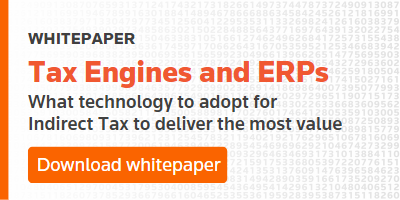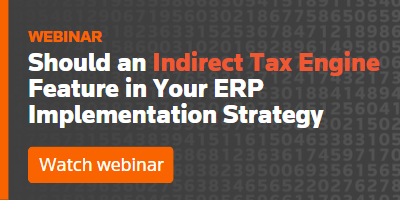Unveiling the Benefits: When and why should your organisation consider an Indirect Tax Engine?
Companies need tax technology that can match the pace of their business transactions and keep pace with change in the tax landscape. This is especially important when it comes to GST/VAT, which is constantly evolving and requires a strong tax control framework.
Choosing the right tax technology is crucial. Without timely and accurate indirect tax determination and compliance support, the tax team’s workload can become unmanageable. There’s also a risk of tax errors and compliance failures, impacting operational efficiency, customer service, investor relations, and even the bottom line, potentially damaging the organisation’s reputation and tax risk profile.
We teamed up recently with Deloitte to look into when a tax engine is a right fit for an organisation. For the many that a tax engine makes sense, the ROI can be huge.
Read on to work out what strategy is right for you and the 5 reasons why your multinational organisation could see real rewards by implementing an indirect tax engine.
What’s the most prudent technology strategy?

Some companies try to handle tax determination and compliance in their ERP systems, but this can have risks and opportunity costs. ERPs are crucial in IT environments but aren’t built to focus on tax management. Consequently, tax is often overlooked during ERP implementation or upgrades, leading to over-reliance on existing tax coding or manual processes with higher error rates. These inefficiencies demand more resources from finance and tax teams to produce the right output. Creating a reliable tax configuration in an ERP necessitates expert tax knowledge and constant updates for tax or business changes. Nevertheless, some companies might not feel the necessity to go beyond an ERP-centric approach. Tax leaders may assume that since indirect tax rates are stable in Australia and there are no state-based or local taxes, there’s no substantial benefit to implementing a tax engine. This perspective, however, may be short-sighted. As organisations expand globally into multiple jurisdictions, the need for an engine that can deliver accurate tax rates becomes even more crucial.
For these and other reasons, a tax engine is often a more efficient and valuable solution for managing indirect tax requirements. A cloud-based tax engine that integrates with all other IT systems and runs automatically can ease the burden on in-house tax and IT teams by reducing manual processes and providing a better control framework.
5 key reasons to consider integrating an automated cloud-based tax engine.

For multinational organisations, an ERP alone doesn’t always solve everything. The need for a cloud-based tax engine with an automated compliance tool that integrates into their current IT environment can offer so much more. Here are 5 reasons why.

#1. Reduce the risk of invoicing errors.
Using disconnected ERP systems in a multi-entity organisation can hinder data flows and create inconsistent tax reporting and compliance, making it difficult to gain a comprehensive view of tax obligations. This increases the risk of invoice errors, duplicate payments, incorrect tax codes, and heightened audit and penalty risk.
A robust tax engine with an automated compliance tool provides a centralised solution for automating indirect tax decisions. It connects ERP and business systems, calculates indirect tax, updates rules and rates, and manages millions of transactions daily in complex markets. This reduces the risk of invoicing errors and compliance breaches.
| Thomson Reuters recently commissioned Forrester Consulting to conduct a Total Economic Impact™ (TEI) Study that measured the TEI of ONESOURCE Indirect Tax technology on a composite organisation.[1] The research revealed that over three years, the organisation achieved a number of risk-adjusted present value (PV) quantified benefits, including a significant reduction in tax invoice error rates, which decreased from over 75% to below 1%. |

#2. Increase operational efficiency, decrease costs.
Implementing a content-enabled tax engine may carry immediate costs, but the long-term ROI outweighs these expenses. It frees tax teams from time-consuming data mapping and manual tasks, boosting efficiency and reducing operating costs. It also ensures timely compliance and adaptability to tax changes, minimising the risk of errors, late filings, adverse audit findings and penalties. All this allows tax teams to focus on higher-value work.
| The Forrester Consulting study[2] found that the composite organisation achieved significant efficiency gains with ONESOURCE Indirect Tax technology, saving $494,000 for the compliance team, $468,000 for the indirect tax team, and reallocating 3 FTEs to focus on more strategic work. |

#3. No need to wholly manage GST/VAT changes and tax codes in-house
Where ERPs or custom add-ons have embedded tax codes and rules that require manual updates, a cloud-based and content-enabled tax engine is more efficient since it automates tax coding and rule updates.
An ERP-centric approach necessitates significant investment in tax research to track tax changes. IT or tax teams must then manually update and test new tax logic for each ERP platform used.
Using solutions such as ONESOURCE Indirect Tax Determination and ONESOURCE Indirect Tax Compliance provides relevant, current content from local tax authorities and tax experts. Any time there is a change in the indirect tax landscape, ONESOURCE automatically updates any ERP system that’s connected to the tax engine. There’s no need for research, development or testing.
| The Forrester Consulting study[3] found that manual research and implementation of global tax rate and regulatory code changes requires around 4,800 hours (or 6.5 months) of IT personnel time every year. The composite organisation was able to significantly reduce IT maintenance through automated change updates, saving $297,000. |

#4. Improve indirect tax controls and audit trails
With revenue authorities placing data and technology at the centre of their review activity, a robust tax control framework is vital. Effective data controls for indirect tax are crucial to ensure accurate calculation, allocation, recording and reporting of indirect tax amounts.
A well-designed tax engine with an automated compliance tool offers:
- Centralised, automated tax determination, calculation, and reporting processes across multiple jurisdictions for better visibility and control over indirect tax obligations
- Configurable workflows and approval processes that ensure indirect tax decisions are appropriately authorised and documented
- Robust reporting capabilities and audit trails that allow tax teams to track changes and review transaction details, ensuring compliance with regulatory requirements and reducing the risk of errors and discrepancies
- Automated records and logs of tax procedures that provide documented proof of compliance, providing supportive evidence in case of a dispute over alleged non-compliance

#5 Ensure reliable, real-time access to data.
Business disruptions can result from ERP failures, which is why cloud-based technology is specifically designed to prevent such occurrences. A reliable cloud-based tax engine ensures continuous operations, high-level technology expertise, and near-certain uptime (provided the vendor has top-notch data centres). This allows indirect tax teams to manage tax on a transaction-by-transaction basis and comply with new tax obligations that require reliable, real-time access to data, such as e-invoicing.
In summary…
Relying on ERP capabilities for indirect tax management may be short-sighted due to opportunity costs and risks in a dynamic landscape. Integrating a cloud-based tax engine with an automated compliance tool ensures efficient processes, accurate tax calculations, and adaptability to new challenges, supporting business innovation and growth.
Based on the co-authored whitepaper and webinar by Deloitte and Thomson Reuters.
Like what you read? Then you’ll love these…
Discover ONESOURCE Indirect Tax
ONESOURCE Indirect Tax Compliance
Complete indirect tax compliance, anywhere you operate.
With real-time rates, rules and content, you can save your teams time whilst avoiding audit penalties. Why not factor out risk and move forward with numbers you can count on.
ONESOURCE Indirect Tax Determination
Harness the power of automation with determination done right.
In a complex indirect tax environment, automation is a game-changer. Calculate tax in milliseconds, accelerate efficiency and take risk out of the equation with numbers you can count on.
[1] https://www.thomsonreuters.com.au/en/resources/tax/reports/forrester-total-economic-impact-report/form.html
[2] https://www.thomsonreuters.com.au/en/resources/tax/reports/forrester-total-economic-impact-report/form.html
[3] https://www.thomsonreuters.com.au/en/resources/tax/reports/forrester-total-economic-impact-report/form.html




